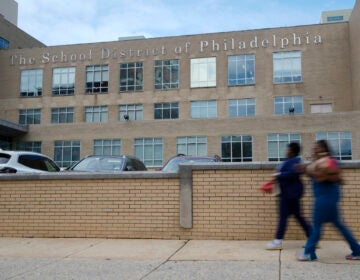Report reveals eye-opening data on English learners in Philadelphia schools

An analysis by the Philadelphia Education Research Consortium tracked English learner students who entered kindergarten in Philadelphia public schools in 2008 and then followed them through third grade. (Wavebreak Media Ltd./Bigstock)
New research offers rare insight into how quickly Philadelphia’s immigrant students learn English, revealing hopeful signs as well as troubling trends.
The analysis, conducted by the Philadelphia Education Research Consortium, tracked English learner students who entered Philadelphia public school kindergarten in 2008 and then followed them through third grade.
Researchers found almost 60 percent of those kindergartners became proficient in English during their first four years in Philadelphia schools.
“There are some things to celebrate,” said co-author Ruth Curran Neild. “Students are learning English.”
But there were wide, inexplicable gaps between the types of students who reached proficiency and the specific modes of language students were able to master.
For instance, 88 percent of kindergartners could read English proficiently by the end of third grade, similar to the proportion who could speak and understand the language. Yet only 48 percent of that same cohort could write English proficiently.
Researchers also discovered that students whose native language was Spanish lagged far behind students with other, commonly spoken languages.
Only 43 percent of Spanish-speakers gained English proficiency in four years, compared with 64 percent of Khmer speakers, 68 percent of Arabic speakers, 72 percent of Vietnamese speakers, and 79 percent of Chinese speakers. Analysts couldn’t explain the discrepancy, but they noted socioeconomic status and the relative prevalence of English in a student’s home environment could be factors.
Spanish speakers made up more than 40 percent of the kindergartners studied, making them by far the largest language group in the cohort.
It’s difficult to contextualize this data, said Neild, because similarly styled studies don’t exist for other large, urban school districts. Neild and other researchers hope this study can serve as a baseline for Philadelphia’s efforts to education English learners, with officials revisiting the numbers periodically to check their progress.
“This isn’t about comparing Philadelphia to other districts, but we really wanted Philadelphia to try to look carefully at itself,” said Neild, who added that the idea for the analysis came from district officials.
Waves of immigration
The issue of how to best educate English learners is one of increasing importance in Philadelphia schools; those students make up just over 10 percent of the district population, a number that has climbed steadily in recent years.
It’s no secret why. Immigrants have flooded Philadelphia in recent years, helping to drive the city’s first sustained period of population growth in decades. From 2014 to 2015, 12,465 immigrants settled to Philadelphia, more than six times the number who came to Philadelphia from 2009 to 2010, according to U.S. Census data cited in the PERC report.
The plurality of English learners entering the public school system are kindergarten students — about 37 percent, according to the PERC study. About half enter Philadelphia public schools at ELP level 1, the lowest benchmark on a standardized, six-level scale the district uses for measuring students’ English aptitude.
ELP level 1 students are learning how to “use English words” and “respond to directions,” according to the PERC study.
That leaves Philadelphia’s public school teachers and administrators with the tough task of bringing these newcomers up to speed by the end of third grade.
That’s a crucial benchmark, said Neild; by fourth grade, students are supposed to “read to learn instead of learning to read.” The city and school district also have a stated goal of ensuring every child is reading on grade level by fourth grade.
No neat package of literacy skills
Students are considered proficient when they reach level five on the six-level ACCESS assessment. But ACCESS scores are a composite of oral skills, comprehension skills, reading skills, and written skills. Therefore it’s possible for students to be deficient in one area and still be considered proficient overall.
Take as evidence the 40-point gulf between the percentage of students who could read English proficiently by the end of third grade, but couldn’t write the language. The gap is particularly staggering because reading and writing are lumped together on the ACCESS test as “literacy,” while speaking and understanding are classified as “oral language.” On statewide standardized tests, writing and reading are both covered by the English language arts version of the PSSA.
The PERC study is descriptive, and does not delve into the cause of this gap between reading and writing skills among English learners. But Neild believes the findings are so striking they may point to problems that go beyond simply instruction for English learners in Philadelphia schools.
“I think it’s a possibility that there has been an emphasis on reading in this district because of the focus on literacy and literacy goals by the end of third grade, but perhaps an under-emphasis on writing,” she said.
At the least, Neild said, her team’s research should underscore that literacy skills don’t come in a neat package.
“Reading and writing take specific instruction and opportunities to learn,” she said. “They aren’t just stand-ins for each other.”
One of the other eye-catching statistics in the PERC analysis almost didn’t make the cut. Researchers debated whether to include data that separated students based on their home language, according to Neild, who was recently director of the U.S. Department of Education’s Institute of Education Sciences
“Our sense is that people would have asked that question anyway, and so we wanted to put the data out there to try to provoke a public conversation,” she said.
The Philadelphia Education Research Consortium is a collaboration of the school district, local universities, representatives from the charter sector, and Research for Action, a nonprofit research firm.
WHYY is your source for fact-based, in-depth journalism and information. As a nonprofit organization, we rely on financial support from readers like you. Please give today.





